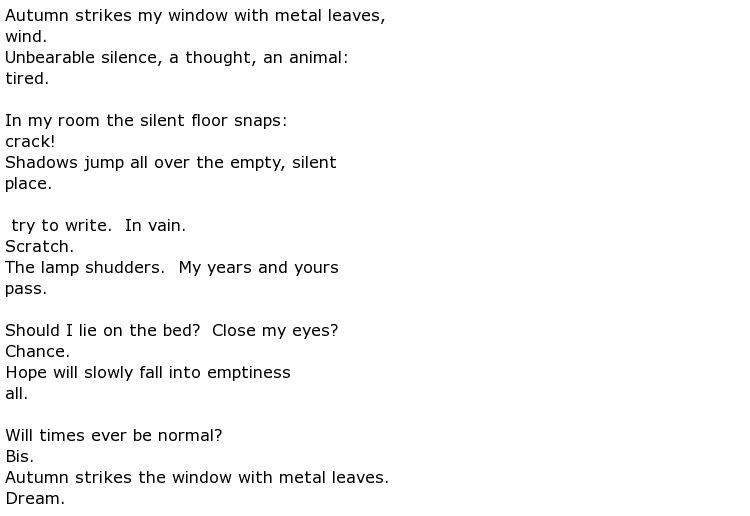 There are conflicting versions of what kind of poet George Bacovia actually was. Initially he was firmly in the Romanian Symbolist camp, progressing later into the realms of Modernism where he received much critical acclaim. Between the two world wars though some saw him as a Neo-Symbolist while others almost dismissed him as a poet lacking in significant ideas. Into the 1950s, which was the last decade of his lifetime, Bacovia’s work took a leap forward and was compared with the work being written for the “Theatre of the Absurd”, where life has no real meaning or purpose and all human communication breaks down. There were also elements of surrealism, expressionism and he touched on the philosophic movement existentialism. He was eventually seen as a major figure in classic Romanian literature.
There are conflicting versions of what kind of poet George Bacovia actually was. Initially he was firmly in the Romanian Symbolist camp, progressing later into the realms of Modernism where he received much critical acclaim. Between the two world wars though some saw him as a Neo-Symbolist while others almost dismissed him as a poet lacking in significant ideas. Into the 1950s, which was the last decade of his lifetime, Bacovia’s work took a leap forward and was compared with the work being written for the “Theatre of the Absurd”, where life has no real meaning or purpose and all human communication breaks down. There were also elements of surrealism, expressionism and he touched on the philosophic movement existentialism. He was eventually seen as a major figure in classic Romanian literature.
He used the name Bacovia as a pen name but he was born George Andone Vasiliu on the 17th September 1881 in the city of Bacau, which is situated in the foothills of the Carpathian mountains. He was a merchant’s son and his parents were able to send him to school very early. He was learning German by the age of six and attended two schools and then the Ferdinand Gymnasium. He was a bright and intelligent pupil throughout, becoming an accomplished writer, artist and musician. Perhaps unusually for a boy with such artistic talents he also excelled at gymnastics.
At the age of 18 he produced his first major piece of work. Purple Twilight was inspired by an incident where he had been accidentally locked in a church tower overnight. In the same year he received a national prize for his “artistic drawings of nature” and had a poem published in the magazine Literatorul. This poem, Şi toate, was to be the start of his literary career.
He tried to study at a military academy but dropped out early as military discipline did not suit him. Next he studied at the Liceul Ferdinand in Bacau and he graduated from there in 1903, going on to the Faculty of Law in Bucharest. He eventually gained a degree in law, in 1911, but never practiced it. Literature was becoming the main focus of his life and he was often found in his home city’s salons reading his poetry to interested listeners. He particularly frequented the salon of Alexandru Macedonski and the two men became close friends.
In 1904 Bacovia wrote Autumn Leaves and it soon became apparent that he had no further need to study law. His future was assured in literature. He spent time living with his brother in Bucharest but was drawn back to his home city after a short time away. At the outbreak of the First World War he was an intern at a Bucharest sanatorium and several of his poems were published in newspapers. He secured the position of co-editor of the review Orizonturi noi and kept himself busy writing book reviews while continuing to have poetry and prose published, often using different pseudonyms. A few years as a civil servant followed in both the education and labour ministries in Bucharest and he rose fairly high in the ranks before illness forced him to resign in 1921.
Here is an example of Bacovia’s haunting style of poetry, called Monosyllables of Autumn.

Alongside more writing he then became a teacher of drawing and calligraphy at a boys school in Bacau and, in 1928, he married a fellow teacher. He was soon to fall on hard times but was rescued by the Romanian Society of Writers who considered his situation and approved a monthly pension of 1000 lei. By 1933 he moved his family to Bucharest where they remained for the rest of his life. Two anthologies of his work were published: Poezii in 1934 and Opere (Works) in 1944.
George Bacovia died at home in Bucharest on the 22nd May 1957, aged 75.

